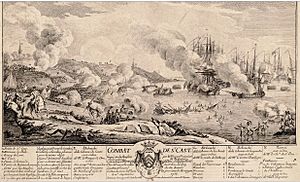Battle of Saint-Cast facts for kids
Quick facts for kids Battle of Saint-Cast |
|||||||
|---|---|---|---|---|---|---|---|
| Part of the Seven Years' War | |||||||
 Engraving by Nicolas Ozanne |
|||||||
|
|||||||
| Belligerents | |||||||
| Commanders and leaders | |||||||
| Strength | |||||||
| 10,000 | 8,000-9,000 soldiers and militiamen | ||||||
| Casualties and losses | |||||||
| 2,300 killed or wounded 800 prisoners |
300 | ||||||
The Battle of Saint-Cast was a big fight during the Seven Years' War. It happened on the coast of France on September 11, 1758. British ships and soldiers tried to land, but French defenders fought them off. The French won this important battle.
During the Seven Years' War, Britain often sent ships and soldiers to attack France. These attacks were called descents. In 1758, several of these attacks targeted the northern coast of France. The British wanted to capture and destroy French ports. They also hoped to make France move its soldiers away from Germany. Another goal was to stop French privateers, who were like private ships attacking British trade. The Battle of Saint-Cast was the last part of one of these large British attacks. It ended with a clear French victory.
Contents
Why Did the Battle of Saint-Cast Happen?
The British forces for this attack were very large. They had many warships and thousands of soldiers. Admiral Lord Anson and Commodore Howe led the naval forces. Lieutenant-General Thomas Bligh was in charge of the soldiers. In total, Britain had about 10,000 soldiers and many more sailors.
The French had soldiers and local militias spread along their coast. They had to quickly bring these forces together to fight the British.
British Success at Cherbourg
Before Saint-Cast, the British had a big success. They captured the port of Cherbourg. There, they destroyed the docks, ships, and a lot of war supplies. This was a major blow to the French.
After Cherbourg, French troops started moving towards the area. The British expedition then sailed towards Saint-Malo on September 5. However, Saint-Malo was too well defended. The weather also turned bad, making things difficult for the British ships.
Moving Towards Saint-Cast
The British decided it would be safer to pick up their soldiers further west. They chose the bay of Saint-Cast, near the small village of Saint-Cast. The British fleet sailed ahead to the bay. Meanwhile, the army marched overland, starting on September 7. They had small fights with French forces along the way.
On September 10, some British soldiers went to Saint-Cast to get food. Lieutenant-General Bligh and his main army camped about 3 miles away.
French Forces Gather
While the British were moving, Richelieu, duc d'Aiguillon was the military commander of Brittany. He quickly gathered a large French army. This army included about 12 battalions of regular soldiers and cavalry. They also had local coastal militia and artillery.
The French army grew to about 8,000 or 9,000 men. Marquis d'Aubigné led them in the field. They marched quickly towards Saint-Cast from places like Brest and Dinan. They were determined to stop the British.
How the Battle Unfolded
On the morning of September 11, General Bligh's army started moving at 3:00 AM. They reached the beach at Saint-Cast before 9:00 AM. But getting the soldiers onto the ships was very slow. The large transport ships were far from the shore. The smaller landing boats were first used to load supplies, cannons, and even horses.
Hardly any soldiers had gotten onto the ships when the French army appeared. The French immediately started firing their cannons at the beach.
The British Rear Guard Fights Back
General Bligh had placed about 1,500 men as a rear guard. These soldiers were from the 1st Foot Guards and other regiments. Major-General Dury commanded them. Their job was to protect the main army as it tried to leave the beach. They hid behind some sand dunes.
There was a lot of confusion and panic among the British soldiers. Everyone was rushing to get off the beach. The French forces moved down a hidden path to the beach. They formed three lines of soldiers, with a fourth line ready behind them.
Five British frigates and some bomb ships tried to help. They fired their cannons to cover the British soldiers getting onto the boats. Their fire pushed back the French lines for a short time. However, the French artillery was in a very good position. Their cannons were on higher ground, overlooking the beach and the bay.
The French cannons fired at the British ships. They also hit and sank three landing boats full of soldiers. Other landing boats were damaged on the beach.
The Final French Attack
When only about 3,000 British soldiers were left on shore, the French moved in closer. Even with fire from the British fleet, the French advanced. A group of 300 French grenadiers, led by Marquis de Cussi and Comte de Montaigu, charged with bayonets.
The British rear guard under Major-General Dury tried to fight back. But Dury was badly wounded and died. The British soldiers broke and ran into the sea. About 800 British soldiers were killed. More than 700 were taken prisoner. The French soldiers chased them into the water. After the fighting stopped, the French helped the wounded British soldiers. The French had about 300 casualties themselves.
What Happened After the Battle?
The Battle of Saint-Cast was the last time Britain tried a large-scale attack on the coast of France during the Seven Years' War. It was a big failure for the British. This disaster helped convince British Prime Minister Pitt to change his strategy. Instead of more coastal raids, he decided to send more military help and soldiers to fight in Europe.
The British realized that these large coastal attacks were too risky and expensive. The temporary gains from such raids were not worth the potential for another disaster.
Images for kids
See also





